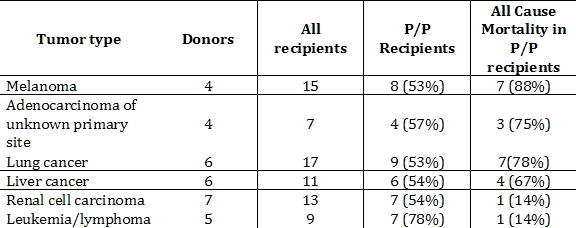Donor-Derived Tumor Transmission Events. A Summary of 2008-2013 Data from the OPTN Ad Hoc Disease Transmission Advisory Committee (DTAC)
1OPTN Disease Transmission Advisory Committee (DTAC), Richmond, VA
2United Network for Organ Sharing, Richmond, VA.
Meeting: 2015 American Transplant Congress
Abstract number: 405
Keywords: Donors, Malignancy, marginal
Session Information
Session Name: Concurrent Session: PTLD and Other Malignancies
Session Type: Concurrent Session
Date: Tuesday, May 5, 2015
Session Time: 2:15pm-3:45pm
 Presentation Time: 2:15pm-2:27pm
Presentation Time: 2:15pm-2:27pm
Location: Room 122-AB
Purpose: Transmission of donor malignancy via transplantation is an uncommon but significant occurrence. The OPTN Disease Transmission Advisory Committee (DTAC) has monitored such complications since 2005 and this report updates events for the 2008-2013 period.
Methods: Malignancy-associated potential donor transmission events (PDTTE) (i.e., one donor and all recipients of that donor) reported to the OPTN Patient Safety System were reviewed.
Results: Of 302 PDTTE reported throughout 2008-2013, 45 were considered proven or probable (P/P). These 45 donors provided organs for 103 recipients, 56 of whom developed cancer (0.033% of all transplants, approximately 1 transmission per 3000 transplants). 76% of tumors were detected within one year and 93% within two years of transplant. All causes mortality during the follow-up period is currently 57% in patients with P/P transmission versus 21% in other exposed recipients (p=0.0002). The most common scenarios, accounting for 71% of PDDTE, are:

For P/P events, the mean donor age was 52 years; that of donors with CNS tumor 10 years and that of donors with adenocarcinoma of unknown origin 66 years.
The number of reported PDDTE rose from 37 in 2008 to 64 in 2013. “Possible” cases (the weakest categorical interpretation) declined from 30 to 3, and the annual number of “excluded” cases rose from 2 to 50 during this interval.
Conclusions: Transmission of donor tumors remains rare. Particular care to exclude donor melanoma or lung cancer should be exercised, as these are associated with significant mortality. Elderly donors may have a slight increase of occult cancers and CNS pathology in pediatric donors should raise suspicion for the possibility of tumor. Trends of reporting suggest that both the quantity and quality of data submitted to OPTN during this period have increased.
To cite this abstract in AMA style:
Nalesnik M, Taranto S, Covington S, Blumberg E, Green M, Gross T, Klassen-Fischer M, Pavlakis M, Wolfe C, Kaul D. Donor-Derived Tumor Transmission Events. A Summary of 2008-2013 Data from the OPTN Ad Hoc Disease Transmission Advisory Committee (DTAC) [abstract]. Am J Transplant. 2015; 15 (suppl 3). https://atcmeetingabstracts.com/abstract/donor-derived-tumor-transmission-events-a-summary-of-2008-2013-data-from-the-optn-ad-hoc-disease-transmission-advisory-committee-dtac/. Accessed January 5, 2026.« Back to 2015 American Transplant Congress
